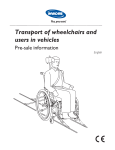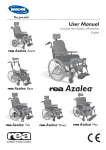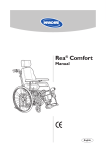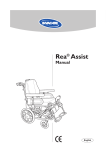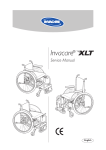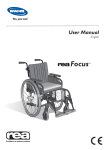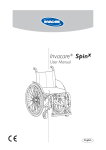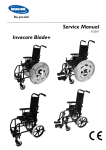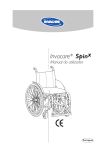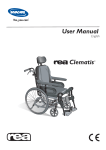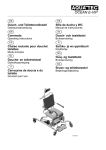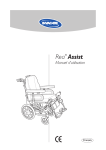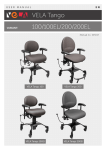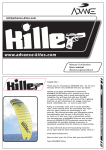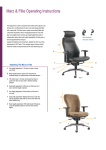Download AzaleaR - Invacare
Transcript
User Manual English Azalea Assist R Azalea Azalea Base R Azalea Tall R Azalea Minor R R 2 Azalea R Contents Product description NB ! Daily performance check Intended use Parts of the wheelchair Lifting the wheelchair Standard equipment Upholstery and frame colours Accessories Technical data Delivery check Assembly 3 4 4 6 7 7 8 8 8 9 10 10 Adjustments Seat Sliding seat Legrests/footrests Footplates/calf pads Central legrest Backrest Armrests Seat unit - User and carer-operated chair - Electrically operated chair Charging the battery Rear wheels Wheelchair heights Brakes Carer-operated brake Push handles/push bar Anti-tip devices 12 13 13 14 15 16 18 Azalea Base 26 18 19 19 20 22 23 23 24 25 Accessories Headrest Neckrest Abduction cushion Trunk support Pelvic belt Harness 27 28 29 29 31 31 Transport 32 34 35 36 37 39 40 Observations Restraint methods Transport of wheelchairs in vehicles Safety instructions/propelling techniques Guarantee Recycling Azalea R 3 NB! This symbol means warning. Below you will find a number of points affecting your personal safety. Read them carefully! Invacare is only responsible for product changes carried out by personnel who we authorise. We reserve the right to make any changes to equipment and specifications without prior notice. Failure to comply with instructions given may result in personal injury and/or product damage. • • • • • • • • • • • • • • Check each of the following before using the wheelchair: – that all parts are attached securely to the frame – that all wheels, knobs, scews and nuts are properly tightened – that all brakes and anti-tip devices function correctly Never lift the wheelchair by the detachable armrests, footrests, backbrace or by the adjustable push handles. Always apply the brake before getting into or out of the chair. Never stand on the footplates when getting into or out of the chair, because of the risk of tipping. Changing the seat angle gives an increased risk of tipping over. The handrims may become hot due to friction, which may cause injury to your hands. Use extensively the anti-tip device Remember that the effectiveness of the carer-operated brake is reduced in wet and slippery conditions, as well as when on a slope. Be careful to ensure that the rearwheels are securely attached. There is a risk of tipping and injury if the velcro straps on the backrest become too slack. Always check the tension. Surfaces of the wheelchair like frame parts or upholstery can, after long exposure to the sun, reach temperatures over 41°C. When mounting accessories etc. be careful not to trap your fingers. There is always an increased risk of trapping parts of your body when tilting the wheelchair’s back and seat. The width of the seat should never be adjusted so much so that the inside of the armrests press against the side of the pelvis. Daily performance check Check that the following parts are still currently assembled on the wheelchair: • Wheels • Backrest • Anti-tip device • Push handles • Footrests 4 Azalea R Product description Rea® Azalea Rea® Azalea is a wheelchair with many adjustment options and accessories. To ensure that you benefit as much as possible from Rea® Azalea, and in order to do its options justice, the chair must be tested and adjusted by competent personnel. We hope that you have also received instructions for using your Rea® Azalea in everyday life. This manual includes a description of the parts of the chair, simple adjustment options, how to use the Rea® Azalea safely and how to transport it. The manual must be read thoroughly before the chair is used. Also included in this manual is a description of how all accessories are fitted and slightly more advanced settings. As the Rea® Azalea has many different components and accessories, the appearance of the accessories you have for your chair may differ from those shown. The Rea® Azalea’s wheels, seat frame, legrests, push handles and certain other components subjected to strain are made of steel. Backrest rails are made of high quality aluminium. Footplates and side supports are made of reinforced plastic. The seat plate is made of wood and the backrest plate is made of wood and the upper part of plastic. Plastic details are marked for recycling. Seat and backrest cushions are made of polyether and the upholstery is made of washable plush or elastic polyurethane cloth. The Rea® Azalea is a manual wheelchair with an angle-adjustable seat unit. The angle of the backrest unit can be adjusted independently of the seat. The seat and backrest controls can be operated manually by the assistant or electrically by the user or by the assistant. The Rea® Azalea is available in three widths. The seat depth, backrest height, armrest height, armrest depth, legrest height and legrest angle of each chair can be adjusted. The height of the chair can also be altered. The rear wheels are 24” or 22”, the castors are 140 mm-200 mm. The wheels can be pneumatic or semi-solid, with or without a carer-operated brake. 16” transport wheels, with carer-operated brake, can also be chosen. The seat and backrest cushions are designed to provide good stability and comfort for the user as well as good pressure distribution. Azalea R 5 Intended use Rea® Azalea General The Rea® Azalea is a manual wheelchair, intended for users who can propel the chair to a certain extent and operate the angle adjustment themselves, and who remain seated for long periods. Rea® Azalea’s comfort and stability, as well as the option of adjusting the angle of the seat unit and backrest, comprise an ideal combination for activity and comfortable rest. Regarding both operation and adjustment of seating position, the Rea® Azalea is intended for operation by the user or carer. However, the user must be fully aware of the effects of changes made. • • • The Rea® Azalea must be used with its seat and backrest pads. Max. user weight is 135 kg. The service life of the chair depends on its application, the user’s degree of activity as well as care and maintenance. Additional information for Rea® Azalea Minor The Rea® Azalea Minor is intended for smaller adults and teenagers, who are passive users, both semi-dependant and dependant. • • Max user weight is 75 kg. Please note that the harness has to be fitted and adjusted by a trained therapist. Intended use Rea® Azalea Base The Rea® Azalea Base is a part of the Azalea family that is meant as a wheelchair base for different seating systems such as individually adapted anatomic seats manufactured by different companies. The Rea® Azalea Base is intended for use both indoors and outdoors. The maximum allowed weight load on the Rea® Azalea Base is 135 kg. This includes both user and seating system. The Azalea range is CE-marked, but since the Rea® Azalea Base is not to be considered as a complete product and it is only when the base and the seating system have been combined that an evaluation of the safety can be done, it rests upon the company that mounts the seating system to perform such an evaluation. However, if there is an agreement between Invacare and the manufacturer of the seating system that regulates the responsibility between the companies, the product can maintain its CE-marking. In other cases, the company mounting the seating system will be responsible for the CE-marking or that the chair will be registered and documented as a specially made medical technical product. The Rea® Azalea Base has been crash tested together with the Invacare standard back and seat, but no other combinations have been tested and Invacare can in no way predict the effect of an accident with other configurations. Other tests performed on the Azalea Base have also been carried out with the standard back and seat from the Azalea range mounted. 6 Azalea R Parts of the wheelchair 2 4 12 5 3 7 1 13 10 11 6 8 9 1. Backrest 2. Push handle 3. Neckrest 4. Armrest 5. Rear wheel 6. Rear wheel plate 7. Anti-tip device and step tube 8. Brake 9. Castor 10. Seat 11. Legrest 12. Handle for backrest angle and seat tilt adjustment 13. Allen key for adjustments (on back of backrest cushion) Lifting the wheelchair Always lift the wheelchair by gripping the frame at the points shown in the diagram. Never lift the wheelchair by the removable armrests or the foot-rests. Ensure that the backrest and push bar are securely in place. Also read the chapter Safety instructions/propelling techniques. Azalea R 7 Standard equipment Seat width Seat depth 34 - 59 cm 38-55 cm Backrest height 62,5 + 20 cm without seat cushion Upholstery and frame colours Upholstery Grey Plush, TR32 Grey Dartex, TR23 Frame colours Pearl Grey Accessories Rea® Azalea has a wide range of accessories and options. Some of the accessories may not be available in all countries or suitable for all models. Backrest type Backrest plate Backrest tension adjustable Backrest cushion Laguna (lateral support) Mistral 2 (waist support) Passad 2 (shoulder support) Shoulder High 05 Vicair Multifunctional Backrest cover Cover Thin, 04 Cover, Lateral 05 Seat Standard H-bracket (Azalea Base) Seat plate (Azalea Base) Seat cushions Vicair Multifunctional Flo-shape Seat and backrest Carer- operated recline Electrically operated by carer/user adjustment Legrests Angle adjustable Fixed 80°, 90° Legrest amputee 8 Footrests Fixed footplate Angle and depth adjustable Foot plate extender Heel strap Armrests Height adjustable armrest Hemiplegic Autolock armrest Castors 140–200 mm, pneumatic or solid, wide or narrow Rear wheels 16", 22", 24", pneumatic or puncture-proof Brakes User brake Hand operated assistant brake Others Reflector Kit Table Tray Pump Cane holder Headrest Headrest with cheek support Neckrest Push bar Push handles braced Pelvic Belt Harness (Azalea Minor) Trunk support Azalea R Technical data Seat width Seat depth Seat height Backrest height Legrest length Tilt adjustment Total width Total height Weight Maximum user weight Transport weight Backrest adjustment Armrest height Total length Azalea Azalea Assist Azalea Tall Azalea BaseAzalea Minor Seat width 39-55 cm 39-59 cm 39-59 cm 34-59 cm 34-44 cm Seat depth 43-50 cm 43-50 cm 48-55 cm 38-50 cm 38-45 cm Seat height 40/45 cm 40/45 cm 50 cm 40/45 cm 40/45 cm Backrest height 50-80 cm 50-80 cm 50-80 cm - 55-65 cm Armrest length 24-36 cm 24-36 cm 24-36 cm 24-36 cm 24-36 cm Legrest length 33-50 cm 33-50 cm 33-50 cm 33-50 cm 33-50 cm Tilt adjustment -1° - 20° -1° - 25° -1° - 20/25° -1° - 20/25 -1° - 20/25° Total width sw+25 cm sw+22 cm sw+22 cm sw+22 cm sw+ 22 cm Total height 90 - 125 cm 90 - 125 cm 100 - 130 cm 90 - 130 cm 90-125 cm Total depth 95 - 102 cm 95 - 102 cm 95 - 107 cm 95 - 102 cm 90-97 cm Weight 34 kg 34 kg 36 kg 20 kg 32 kg Max user. weight 135 kg 135 kg 135 kg 135 kg 75 kg Transport weight 16.5 kg 20.5 kg 18.7 kg 15 kg 14.5 kg Backrest angle adjust 0° - 30° 0° - 30° 0° - 30° 0° - 30° 0° - 30° Azalea R 9 Delivery check Any transport damage must be reported immediately to the transport company. Remember to keep the packaging until the transport company has checked the goods and a settlement has been reached. Assembly When you receive your wheelchair, you must fit the backrest, armrests and legrests onto the chair. The assembly is simple and does not require any tools. 1. 1. Backrest The backrest is fitted onto the wheelchair by sliding the profiles (A) of the backrest onto the tubes of the chair (B). make sure that you push the backrest down as far as possible. Secure into place by tightening the knobs (C). A Secure the backrest cushion using the Velcro strips. Now check that the backrest is secured firmly in position! C B When fitting the push bar/push handles be aware to place the wires outside the handwheels. Otherwise the wires can be damaged. 2. 2. Armrests Attach the armrests by feeding them into the attachment (D) at the sides of the wheelchair. Push them downwards until you can feel that the armrests are securely in place. D 10 Azalea R Legrests/footrests The wheelchair can be equipped with either angle adjustable legrests or fixed footrests. 3a. 3a. Legrests angle adjustable Attach the legrests by pushing the tube at the upper part of the legrests down into the tubes on the wheelchair. You must angle the legrests outwards when inserting them. Lock the legrests by turning them inwards. The legrests are automatically locked so there is no risk of them coming off the wheelchair. 3b. Legrests fixed Attach the footrests by pushing the tube at the upper part of the footrests down into the tubes on the wheelchair. You must angle the footrests outwards when inserting them. 3b. 4. B Lock the legrests by turning them inwards. The legrests are automatically locked so there is no risk of them coming off the wheelchair. 4. Rear wheels Attach the rear wheels by pressing button (A) in the centre of the hub whilst simultaneously sliding the axle (B) into the rear wheel position attachment of the positioning plate. It is very important that you check that the locking pin has actually locked the wheel into position when the centre button has been released. Take hold of the wheels and try to detach them. This should NOT be possible. A Azalea R 11 Adjustments SEAT 1. The seat depth of the chair can easily be adjusted to provide good support. The width between the legrests and armrests and the height of the armrests can also be adjusted. 1. The seat cushion is secured with Velcro strips on the seat plate. 2. 2. Depth adjustment Remove the seat cushion and loosen the screws (A) with an Allen key. Move the front edge of the seat forwards or backwards, and retighten the screws. The distance between the back of the knee/calf and the cushion should be as small as possible, but without contact. Replace the seat cushion. A Tool: 5 mm Allen key 3. Width adjustment a. Loosen the screw (B) with an Allen key. Adjust the armrests to the desired width and retighten the screw. 3. a. Tool: 5 mm Allen key B b. b. Loosen the screws (C) with an Allen key. Adjust the legrests to the desired width and retighten the screws. Tool: 5 mm Allen key C c. 12 c. The seat width can be decreased with 2x20 mm by placing cushions inside the aremrest pocket. Azalea R SLIDING SEAT (accessory) The sliding seat is a great help to the user when moving into or out of the chair. The user must sit in the chair when the seat is moved forwards. Pull the lever (A) upwards at the same time as you pull the handle (B) and move the seat forwards. B A Remember that the sliding seat increases the seat height by about 3,5 cm. Please observe that the sliding seat is not compatible with the Tall-kit for long users. When you adjust the seat only use the handle. The tip risk increases when the seat is slided forward. angle adjustable Legrests 1. Angle adjustable legrests support the legs and reduce pressure. The legrests can be used for bandaged legs, but not for legs in plaster casts. The legrests must always be fitted with calf pads, footplates and heel straps. It is important to adjust the height and angle of the legrests to obtain a good seating position. 1. Height adjustment Loosen screw (A) with an Allen key. Adjust the legrest into a suitable height and the screw is caught by one of the recesses on the legrest tube. Then retighten the screw. A 2. Tools: 5 mm Allen Key B 2. Angle adjustment Pull the lever (B) with one hand while supporting the legrest with your other hand. When a suitable angle is obtained, let go of the lever and the legrest will look into one of seven preset positions (C). Do not place anything heavy, or let children sit on the legrest. It may cause damage to the mechanism. C Azalea The distance between the lowest part of the footrest and the ground must be at least 40 mm. R 13 Fixed Legrests Height adjustment Loosen screw (A) with an Allen key. Adjust the legrest into a suitable height and the screw is caught by one of the recesses on the legrest tube. Then retighten the screw. NOTE! Don't touch the upper screw (C). The distance between the lowest part of the footrest and the ground must be at least 40 mm. C A Tool: 5 mm Allen key FOOTplate/CALFPAD 1. Angle-adjustable footplates Adjust the angle and the depth by loosening the screw (A) at the footplate attachment with a 5 mm Allen key. Adjust the footplate to the correct position and retighten the screw. 1. Do not place anything on the footplate when the screw is loose. Tool: 5 mm Allen key A 2. D B C 2. Calf pads The calf pads can be fitted in four different depth positions. Swing the pad forwards. Unscrew screw (B) using an Allen key. Remove the large nut (C) on the reverse side and place it in the other attachment hole. Move the calf pad to the new position and secure it into place with the screw. The height of the calf pads can easily be adjusted using the handwheel (D). Tool: 5 mm Allen key 14 Azalea R CENTRAL legrest 1. A 1. Adjust to the appropriate leg angle using knob (A). When adjusting the angle of the central legrest, loosen the adjustment knob with one hand and hold the foot plate with the other hand to avoid trapping yours or anyone else’s fingers etc. When the seat is tilted forwards on a chair with a long legrest length and low seat height, there is a risk of the legrest hitting the floor and causing damage. 2. You can adjust the height of the legrest in the following two ways: 2. Alternative 1: Loosen the Allen screw (B) using a 5 mm Allen key on the front of the telescopic tube, place the legrest in the desired position and secure it into place using the Allen screw. Alternative 2: Loosen the Allen screw (C) by the legrest attachment as shown in the diagram. Adjust to the desired height and then retighten the screw. B C 3. Loosen the rear screw (D) on the side of the tube and adjust the legrest to the desired angle. Retighten the screw. Repeat this procedure to adjust the angle of the other legrest. 3. D Tool: 5 mm Allen key Azalea R 15 4. Loosen the frontal screw (E) on the side of the tube to adjust the depth of the legrest. Tighten the screw when you have found the desired depth. Repeat this procedure to adjust the depth of the other legrest. 4. E 5. 5. The angle of the legrests can be adjusted upwards if required. 1. Footrest, one piece A 1.Adjust the angle and the depth by loosening the two screws (A) at the footplate attachment with a 5 mm Allen key. Adjust the footplate to the correct position and retighten the screws. Do not place anything on the footplate when the screws are loose. Tools: 5 mm Allen Key 2. 16 2. The footrest can be flipped up. Lift the left side of the footrest upwards. Be careful not to trap your fingers between the footrest and the reciever when folding it down. Azalea R Backrest 1. Backrest plate 1. You can easily adjust the backrest plate (+ 10 cm) by loosening the two upper screws (A) with a 5-mm Allen key. Set at the required height and re-tighten. B 2. The upper section has two height levels and it is also removable (to fit lower backrest cushions). Loose screws (B) with an 5-mm Allen key and raise it to its highest position. For removal, remove the screws (B). 2. 1. Tension adjustable 1. For raising the height (+12,5cm), loose screw (A) and lift the backrest frame up. A 2. 2. For shaping the form, loose the Velcro straps, tighten first where you would like to have a firm support and follow with the others. Check that the cover/cushion do not "lock" the straps by the Velco attachment. Please ensure that the velcro straps are not too loose, as this will result in your back coming into contact with backrest bow (A), and could result in injury. Azalea R 17 ARMRESTS 1. Armrest height 1. Adjust the height of the armrests by turning the knob or Allen key screw (A), setting the required height and then re-tightening the knob/screw. Be aware not to trap your fingers between the armpad and the sidesupport when you adjust the armrest height. A Armrest depth 2. You can also adjust the depth of the armrest pad. Loosen the knob (B), set the pad in the required position and re-tighten the knob. 2. B Seat CARER-OPERATED ANGLE ADJUSTMENT 1. C 1. Tilt adjustment Tilt of the seat unit (seat and backrest) by pulling the right-hand lever (C) upwards and keeping it there whilst you tilt the seat unit to the required position. Release the lever (C). 2. D 18 The wheelchair is equipped with carer-operated controls. You can adjust the angle of the backrest forwards or backwards and tilt the whole seat unit including the backrest. These two functions can either be controlled manually or electrically. Be careful when adjusting the angle of the backrest so that you do not trap your or the user’s fingers between the backrest and the armrest. 2. Backrest angle adjustment Adjust the angle of the backrest by pulling the left-hand lever (D) upwards and keeping it there whilst you push the backrest away from you or pull it towards you until you have obtained the required position. Release the lever (D). Azalea R ELECTRIC tilt and backrest ANGLE ADJUSTMENT 1. B C 1. Tilt adjustment Tilt the seat unit (seat and backrest) by using the lower part of the control panel. Press (B) to adjust the angle of the seat unit backwards or press (C) to adjust the angle forwards. The hand control should only be used by authorised personell. The risk of trapping fingers, etc, is greater in electric adjustments than in user-operated adjustments. Bear in mind, for example, that a child may get hold of the controls and get trapped, or trap the user. 2. B C 2. Backrest angle adjustment Adjust the angle of the backrest by using the upper part of the control panel. Press (B) to adjust the angle of the backrest forwards or press (C) to adjust the angle backwards. The risk of trapping fingers, etc., is greater in electric adjustments than in user-operated adjustment. Bear in mind, for example, that a child may get hold of the control box, press the controls and get trapped, or trap the user. The hand control should only be used by authorised personnel. CHARGING THE BATTERY 3. 3. Charging the battery If your wheelchair has electrical angle adjustment the battery needs to be charged. If the angle adjustment function has been used during the day, it is a good idea to leave the charger on overnight. Charge the battery by plugging the battery charger supplied with the chair into a wall socket. Then Insert the the charger cable into the connector which is on the side of the wheelchair as illustrated. It takes about 12 hours to charge a battery that has been used 50% of its capacity. Work on the handset should only be carried out by properly trained personnel. Azalea R 19 REAR WHEELS ADJUSTMENT 22”-24” 1-2. You can adjust the height of the seat by moving the rear wheel attachment upwards or downwards.The balance of the wheelchair can be adjusted by moving the rear wheel attachment forward or backward. When the attachment is moved forwards, the chair will be somewhat easier to propel, but the risk of tipping will increase. If you move the attachment towards the rear, however, the chair will be more stable but slightly harder to propel. Test the different settings to see what suits you best. A The risk of tipping increases when the rear wheels moved forward. Compensate by mounting an anti-tip device on the wheelchair. Tool: 24 mm fixed spanner 1. Horizontal position Loosen the rear wheel housing (A) with a spanner. Move the housing to the required position, either further forwards or backwards. Make sure that you tighten the housing securely when you have decided on the position. The axle housing should be tightened with a manual and dynamometric wrench calibrated to 40 Nm. Now check the position of the brakes, and that the user can move the chair safely in its new balance position. 2. Height Loosen and remove the attachment (A) using a spanner. Then move the rear wheel attachment to the height required, and then retighten the nuts (A). Is the position in height changed, the size of the rear wheels must also be changed. See the height table for correct positioning. REAR WHEELS ADJUSTMENT 16” 1. The 16” transit wheel can be placed in two different positions. The front position is the standard position. When accessories is mounted on the back of the wheelchair the tip risk increases and therefore the rear placed attachment should be used in this case. When fitting the wheel make sure to place the attachment (B) correctly. A B 20 C 1. Front position (C) Assemble the mounting as shown in picture 1. Azalea R 2. D 2. Rear position (D) Assemble the mounting as illustrated in picture 2. When you have fitted the wheels in the correct position, it is important that you check thoroughly that the nuts and screws are tightened securely. This is important for your own safety! B A Azalea R 21 Wheelchair heights 1. Rea® Azalea & Rea® Azalea Assist 110 1 2 4 3 45 45 45 40 40 40 40 45 45 45 4 3 2 1 5 24" 24" 24" 22" 22" 16" 16" 16" 16" 16" 150 2 2 2 1 1 4 3 2 1 1 2 2 3 3 3 3 1 4 4 3 3 3 2 2 200 150 140 150 140 150 140 200 150 140 2. Rea® Azalea equipped with Tall-kit 150 4 4 3 2 1 5 50 50 24" 16" 4 5 2 3 200 200 3. Rea® Azalea Base 150 110 45 45 45 40 40 45 45 45 40 40 22 24" 24" 24" 22" 22" 16" 16" 16" 16" 16" 1 2 4 3 5 4 3 2 1 2 2 2 1 1 3 3 3 4 3 2 1 1 2 2 3 3 1 2 2 4 4 3 3 200 150 140 150 140 200 150 140 150 140 Azalea R BRAKES Start by checking that the tyres have the correct air pressure (printed on the side of each tyre). 1. A 1. User brake The user brake is to be used when the chair is not moving, and is not intended for reducing speed when the chair is moving. To apply the brake, move the lever (A) forwards. To release the brakes, move the lever towards the rear (towards you). Be careful not to trap your fingers between the brake pin (B) and rear wheel. 2. 2. To attain the correct braking effect, the brake pin should press into the tyre when you apply the brake. The brake may therefore require depth adjustment. Loosen the screw (A) and move the brake attachment to the required position. Retighten the screw (A). There should be a distance of approximately 6 mm between the pin (B) and the tyre (C). A C B Tool: 5 mm Allen key Be careful not to trap your fingers between the brake pin (B) and rear wheel. Incorrect setting or use of the brake reduces the braking effect. CARER-OPERATED BRAKE 1. 1. Braking when moving: squeeze both brake handles upwards, and the brake will be applied. 2. 2. Locking the brakes: squeeze the handle and move the lock catch (A) upwards. Then release the handle. A 3. Releasing the brakes: squeeze the handle and the lock catch will release automatically. 3. Incorrect setting or use of the brake reduces the braking effect. Azalea R 23 push handles braced/PUSH bar 1. A 1. Push bar/Push handles braced Loosen the knobs (A). The height of the pushhandles braced/pushbar can be adjusted simply by pulling the handles upwards or pushing them downwards. Adjust it to the height that you require and tighten it. It is important that you do not mix up the upper and lower knobs on the back of the backrest. The lower knobs lock the backrest to the chair, and if these are loosened by mistake, the safety of the chair may be jeopardised! Do not touch these knobs! When fitting the push bar/push handles be aware to place the wires outside the handwheels. Otherwise the wires can be damaged. The push bar/push handles braced must not be pulled up so that it protrudes more than 19 cm over the top edge of the attachment.Do not trap your fingers between the pushhandles brace and the neckrest attachment. (If you have tension adjustable). 19 cm 24 Azalea R ANTI-TIP DEVICES 1. The anti-tip device also acts as a step tube. It is height-adjustable and easy to adjust. A 2. A 1. Press the spring-loaded buttons (A), raise or lower the anti-tip device and ensure that the springloaded buttons (A) pop out into place properly in their new position. 2. Fold the anti-tip device under the wheelchair by pressing the spring-loaded buttons (A), turning the anti-tip device to the required position, ensuring that the buttons (A) pop out again into position. Never forget to fold down the anti-tip devices. Azalea R 25 Azalea Base 1-3. A Backrest angle 1. To adjust the angle of the backrest, first loosen nuts (A) on the rigging screw using a spanner. 2. Turn the metal tube to set the desired angle for the back. 3. Retighten the nuts. Seat There are three options how to attach a seat to the Azalea base. A. 1. Direct on the seat brackets. 2. With the H-bracket (A). 3. On a seat plate (B) . A. H-bracket The H-bracket is used when attaching a quickrealease seat shell to the Azzalea Base. B. B. Seat plate The seat plate is used when attaching seat shells and other seating moduls other than quick-release shells. 26 The H-bracket is adjustable in depth. The seat plate is adjustable in depth. Azalea R Accessories HEADREST 1. The height and the removal are operated by the handwheel (A). The bar is equiped with an adjustable stop block (B). 1. To adjust the height of the head rest, first loosen the screw (B) in the stop block, then loosen the handwheel (A). Adjust the head rest to the desired position and re-tighten the handwheel (A). Now slide the stop block down to the top of the headrest attachment and tighten the screw (B). B A 2. It is now possible to remove the headrest and reinsert it in the desired position without further adjustments. C 2. The angle and depth is adjusted by the two screws (C) and the handle (D). Loosen, adjust and retighten. D 3. 3. The sidewise adjustment is made by loosening screw (E). Adjust and re-tighten. E 4. The angle of the wings is adjusted by loosening screws (D). Adjust and re-tighten. 4. D Azalea R 27 NECKREST 1. 1. To adjust the height of the neckrest, first loosen the screw (B) in the stop block, then loosen the handwheel (A). Adjust the neckrest to the desired position and re-tighten the handwheel (A). Now slide the stop block down to the top of the neckrest attachment and tighten the screw (B). B A 2. C It is now posible to remove the neckrest and reinsert it again in the desired position without further adjustments. 2. The angle and depth is adjusted by the two screws (C) and the handle (D). Loosen them and adjust. D 28 Azalea R ABDUCTION CUSHION 1. 1. The height adjustment and removal is operated by the handwheel (A). A 2. The depth is adjusted in a forward or backward position. Loosen handwheel (A) and turn. 2. A TRUNK SUPPORT With multi adjustable cushion 1. You adjust the height by first loosening the screws (A) whilst moving the attachment (B) upwards or downwards. Re-tighten the screws (A). 1. B A 2a. 2a.Remove the cover and see illustrations to the left for suggestions of: • height and depth adjustment 2b. 2b. • angle Azalea R 29 2c. 2c. • small side support / large trunk support Alt.1 • large side support / small trunk support Alt. 2 Trunk support with fixed cushion. The trunk supports can be adjusted in height, depth and sideways. 3 2 1 G 2 I H 3 1 Tool: 5 mm Allen Key screwdriver 1. You adjust the height by first loosening the screws (G) whilst moving the attachment (H) upwards or downwards. Re-tighten the screws (G). 2. You adjust the trunk supports sideways by loosening the knob (I), moving the support sideways to the required position and then re-tightening the knob (I). 3. To adjust the depth of the trunk supports, first unzip the trunk support cover to reveal the screws inside. Unscrew them using a screwdriver, and move the trunk support forwards or backwards. Retighten the screws and zip up the cover. 4. Remove the trunk support by loosening knob (I) and pulling the trunk support sideways and outwards. Be careful not to trap your arm between trunk support and armrest when changing the angle of the backrest. 30 Azalea R PELVIC BELT 1. 1. The pelvic belt is used to prevent the risk of falling or sliding out of the chair and for providing the user with a good posture. 2. The pelvic belt is mounted on the backrest brackets. Thread the belt through the mounting on the chair and then through the two plastic buckles as shown in the picture. It is important that both buckles are used. There is a danger the belt might slip if the belt is threaded through only one. 2-3. 4. 3. Adjustment Ensure that the user is sitting fully back in the seat and that the pelvis is as upright and symmetrical as possible - not forward on one side or tilted back. Position the lap belt so that the hip bones can be felt above the belt. Adjust the length using the buckles so that there is just sufficient room for your hand to slide between your body and the belt. It is recommended that the clasp is kept in a central position, i.e. make adjustments to each side. These adjustments should be checked and possibly changed each time the belt is used. a b 4. If the belt has come loose at the metallic clasp it should be threaded according to the pictures a-c. Please make sure that the belt cannot slide. c HARNESS This item should be fitted by an experienced clinican or technician.The harness must always be used in combination with the pelvic belt and should be worn on top of the pelvic belt. Make sure that the harness does not put too much pressure on any point. 1. 1. The harness is mounted on the headrest attachment. Remove screws and discard, position washers and harness as shown (A) and insert new screws through the eyelets into the attachment and tighten the screws. A 2. B C 2. To mount the lower straps, loosen the armrest attachments with the screws under the seat. Pull out the attachments approx. 5 cm. The strapmountings should be fastened from the inside of the frame (see illustration 2). Insert the screw (B) through the eyelet and into the hole in the frame as shown. Secure with washer and nut (C). Put the armrest attachment back in its originaplace. Always use a harness in combination with a pelvic belt to prevent the user from accidently sliding down in the wheelchair. Tool: 5 mm Allen Key Azalea R The harness may not be used during transport in a vehicle. 31 Transport How to disassemble your Azalea® to transport it as luggage 1. The Rea® Azalea is easy to prepare for transport. 1. Backrest Remove the backrest cushion by pulling it forwards, thus separating the Velcro straps. Loosen both knobs (A) and pull the backrest directly upwards. Lay the backrest on the seat, where it can remain during transport of the wheelchair. Where applicable, detach the push handles. Be careful with the cables that run from the rear wheel to the push handles. When detaching the backrest and placing it on the seat, try to make sure that the cables hang freely. A B 2. 2. Push handles braced. Loosen the two knobs (B). The height of the handles can be adjusted simply by pulling the handles upwards or pushing them downwards. . 3. Legrests The legrests are loosened by pushing the lever (C) forwards whilst turning the legrests outwards. You can then simply lift off the legrests. 3. C 4. D 32 4. Footrests The footrests are loosened by pushing the handle (D) forwards or sidewards whilst turning the footrests outwards. You can then simply lift off the footrests. Azalea R 4. 4. Armrests, Pull them straight up. 5. 5. Rear wheels Remove the rear wheels by pushing buttom (A) and pulling the wheel straight out. A 6. 6. Lifting the wheelchair Always lift the wheelchair by gripping the frame at the points shown in the diagram. Never lift the wheelchair by the removable armrests or the footrests. Azalea R 33 Transporting wheelchairs with users in vehicles The Invacare Rea™wheelchairs are designed to offer the user the best comfort and safety possible during all kinds of situations in everyday life. This means that compromises have to be made in order to make the product useful. During transport in cars, it is always safest to ride in the car's normal seat with the seatbelt on. You should ride in the car's normal seat and use the seatbelt if possible. If, for some reason, it is impossible to be transported in any other way the wheelchair can be used as a seat in a vehicle if the following rules and regulations are followed. Even if the Invacare Rea™products and the following rules are meant to increase safety during transport in vehicles, injuries to passengers can still occur if an accident should happen. Invacare does not leave any guaranties for the outcome of any accidents during transport of wheelschairs and users in vehicles. The wheelchair is according to standard 7176-19 in a normal adjustment and in a standard configuration. The tested configuration can be found at the end of this chapter. 1. 1.The wheelchair and user should be transported forward-facing in the direction of travel. All auxiliary equipment such as tables, trunk support, abduction cushion etc should be removed and stored safely so that they do not injure anyone during any kind of accident. 2. 3. 34 2.The wheelchair should be secured in the vehicle with a 4-point restraint system. The user should wear a 3-point safety belt secured in the vehicle. Both the 4-point restraint system and the 3-point safety belt should be approved according to ISO-10542-2. 3.The tie-down points on the wheelchair where the restraint system straps should be placed are marked with this symbol. Azalea R 4. 4. In order to be used as a seat during transport in a vehicle, the wheelchair must be equipped with a pelvic belt. 5. 5. The vehicle's safety belt should fit as tightly across the user's body as possible without discomfort. The upper part of the safety belt should fit over the user's shoulder as illustrated. No part of the safety belt must be twisted. 6. 6. The pelvic part of the 3-point safety belt must be worn low across the pelvis so that the angle of the pelvic belt is within the preferred zone (A) of 30° to 75° to the horizontal. A steeper angle is preferred, but never exceeding 75°. 7. 7. The 3-point safety belt must not be held away from the user's body by parts of the wheelchair such as armrests or wheels etc. Incorrect placement of safety belt 8. 8. A headrest should always be used during transport and it should be adjusted as shown in the picture. Incorrect Azalea R Correct 35 RESTRAINT METHODS Rea® Azalea, 22/24" A.Frontal restraints with straps 1. Connect the frontal straps around the castor attachment. See pic A. 2. Release brakes and tension front straps by pulling the wheelchair backwards. Re-apply wheelchair brakes. B. Rear restraints 1. Attach the snap hooks on the rear straps to the vertical rear tube by the rear wheel attachment. 2. Tighten the straps. C. Fastening of pelvic belt and safety belt 1. Check that the pelvic belt on the wheelchair is correctly fastened. 2. Fasten the 3-point safety belt around the user. If there is no pelvic belt in on the wheelchair the user must transfer to the seat of the vehicle, if possible The safety belt should not be kept from the user’s body by the parts of the wheelchair. Never use the harness and pelvic belt in a vehicle as a safety belt. A belt designed for transport in vehicles must always be used. Rea® Azalea, 16" 36 Azalea R TEST REPORT FROM DYNAMIC SAFETY RESTRAINT TEST Test No Rea Azalea: Date: P600377B 10/02/2006 Customer: Invacare Rea AB Test No Rea Azalea Assist: Date: P600662A 23/02/2006 Customer: Invacare Rea AB Test No Rea Azalea Assist Tall: Date: P702421A 22/05/2007 Customer: Invacare Rea AB Test No Rea Azalea Tall: Date: P702421B 22/05/2007 Customer: Invacare Rea AB Test No Rea Azalea Minor: Date: P801009B 25/02/2008 Customer: Invacare Rea AB Pulse specification ISO 7176-19 / ISO-10542 Wheelchair Manufacturer: Model: Configuration: Safety restraint device manufacturer: Unwin Safety Systems Model: WWR/ATF/K/R + WWR/HD/ATF/K/R Attachment device: Unwin Low Profile Rail Configuration: 4 Pt. Restraint User safety belt: Testdummy: Manufacturer: Model: Unwin Safety Systems QIR/3H/ATF/WH Hybrid III Weight: 76 kg Test configuration Chassis: Weight: Backrest: Seat: Armrest: Legrest: Rear wheel: Castor: Accessories: SW44 / SD44 34,5 kg Flex2 fixed with Mistral2 cushion Bris Height adjustable AA Alu2003 24" pneumatic / 16” pneumatic 200 x 30 mm Calfpads, heel straps head-/ neckrest. Invacare Rea AB Rea Azalea, Assist, Tall and Minor Forward facing The safety restraint devices used in this test must be approved according to ISO10542. We have chosen to work with Unwin, a well-known quality manufacturer of safety restraint devices for wheelchairs. Safety instructions/propelling techniques We recommend that you have the chair tested by the qualified person who has prescribed the wheelchair, after he or she has made the adjustments that you request, taking your build and needs into account. We hope that you have also received help in learning how best to use the wheelchair. Start by practising carefully until you are familiar with the wheelchair’s possibilities and limitations. Move to/from the wheelchair Stretching and leaning Propelling up a slope Propelling down a slope 38 Propel the wheelchair as near as possible to the seat that you want to move to. Apply the brake. Remove the armrests or move them upwards out of the way, and detach the legrests or swing them outwards. Do not support yourself on the footplates as this may cause the chair to tip forwards. Propel the wheelchair as near as possible. When stretching and bending, do always have full contact between the backrest and the back otherwise the wheelchair may tip over. Stretching behind the back is not recommended. Many experienced users can propel themselves up a slope. In order not to lose control of the steering and to avoid tipping backwards, you should always lean forwards whilst propelling up a slope. Propel the wheelchair forwards using short, quick strokes applied to the hand rims, in order to maintain speed and steering control. Generally, help is needed on steep slopes. If you have to stop on a slope, it is particularly important to ensure that you do not make any sudden or unexpected backward movements when you start moving the wheelchair forwards again. As the wheelchair is already leaning backwards, such a movement may cause the wheelchair to tip backwards. The maximum gradient of slopes that can be attempted is varied between 3° and 13,5° depending on the user weight and the adjustments of the wheelchairs. We recommend that you obtain the help of one or more assistants when going down steep and wet slopes. First check the slope to see if there are any particular hazards, potholes, slippery sections, etc. Never use the user-operated brake to slow down. When you apply the brake on a downward slope, the wheels lock and the wheelchair can suddenly pull to one side, tip sideways or stop immediately, which may cause you to be thrown out of the chair. Always control the speed with the hand rims. Remember that the hand rims may become hot due to friction, and this may cause injury to your hands. Try to propel down the slope in a straight line as much as possible. Azalea R Climbing a kerb Dismounting a kerb Kerbs – alternative method This method is for when the assistant is always behind the wheelchair and it creates the greatest safety for the user. The following advice is for the assistant: Illustration 1) Adjust the anti-tip devices upwards. Ensure that the user’s feet rest securely on the footrests and cannot slide off. Then tilt the wheelchair backwards and push it forwards against the kerb. Illustration 2) Lower the frontal part of the wheelchair onto the pavement and place yourself as close to the chair as possible, before you lift up the whole wheelchair. Illustration 3) Lean forward and lift/roll the wheelchair over the pavement edge. Illustration 4) Lower the wheelchair onto the pavement so that the weight is divided on all four wheels. Ensure that the wheelchair does not roll backwards. Follow the procedure above, but in reverse order (step 4, 3, 2 and then 1) to move off a kerb. This method is generally used by experienced assistants who are stronger than average. It can also be used when the kerb or step is low and only constitutes a minimal obstacle. The assistant steps backwards onto the pavement and pulls the wheelchair up onto the pavement. It is important for the assistant to use his or her body correctly to prevent injury. Tip the wheelchair backwards and roll the chair over the kerb onto the pavement. Take particular care if the kerb is wet or slippery. Escalators Do not use escalators when you are in the wheelchair. Find out whether there is a lift nearby. Stairs We advise you to avoid using stairs when you are in your wheelchair, where possible. Choose an alternative route instead. We recommend that you receive help from two assistants to get up and down stairs. One assistant walks in front of the chair holding the frame of the wheelchair, whilst the other assistant walks behind the chair, holding the push handles. Check that the push handles/push bar are securely fixed in place before you start. Fold the anti-tip devices upwards. Balance the wheelchair on the rear wheels until the balance point is found. The wheelchair is then rolled down the stairs, step by step, by letting the rear wheels roll over the edge of each step. Assistants must not lift by gripping the removable armrests or legrests. They must remember to lift the chair at the correct points, to use their legs and to keep their backs as straight as possible. Azalea R 39 Guarantee We provide a two-year guarantee from the delivery date. Damage due to wear and tear on upholstery, tyres, (rubber) tubes, hand rims and castors, for example, is not covered by the guarantee. Damage that has been caused through physical violence or abnormal use is not covered. Damage caused by users who weigh more than 135 kg is not covered. The guarantee will only apply if the care and maintenance instructions are followed. Maintenance instructions Your Rea® Azalea wheelchair is easy to keep clean. Cleaning Wipe metal parts and the upholstery regularly with a damp cloth. A mild detergent may be used. If necessary, the upholstery can be washed at 40ºC. Normal washing powder/liquid may be used. For disinfection only use alcohol based detergent. Washing and Disinfection 1. Remove all loose and removable covers and wash these in a washing machine following the washing instructions for each article. 2. Spray the wheelchair with detergent, for example a car-cleaning agent with wax, and leave on to work. 3. Rinse the wheelchair with a high-pressure cleaning or ordinary jet of water depending on how dirty the chair is. Do not aim the jet towards bearings and draining holes. If the wheel chair is washed in a machine the water must not be hotter than 60 degrees. 4. Spray the chair with alcohol for disinfection. 5. Leave the chair to dry in a drying cabinet. Remove parts where water has collected for example in end tubes, ferrules etc. If the chair has been washed in a machine, blow-drying with compressed air is recommended. Wheel and tyres • Wheel axles are to be wiped clean and lubricated with a drop of oil. • Pneumatic tyres have a car tyre valve and can be pumped up using the same type of pump that is used for cars. Recommended air pressure for rear wheels: Standard tyres 3.5 bar 50 psi Low profile tyres 7.0 bar 90 psi Recommended air pressure for castors: (200 mm) 8” 4.0 bar Technical servicing • Only original parts, or those approved and complying with Invacare’s specifications, may be used. • All technical servicing must be carried out by an authorised wheelchair technician or by Invacare’s® service department. The address and telephone number are on the back cover of this manual. • Examine all parts of the wheelchair once a week to check for cracks or other damage. If you discover damage, please contact Invacare immediately. The address and telephone number are on the back cover of this manual. • Screws and nuts are to be checked regularly and tightened securely (this applies to all loose parts). Service life We estimate that the Rea® Azalea has a service life span of 5 years. It is difficult to state a precise service life span for our products. The stated period is an estimation of average life span based on normal use. This life span may be considerably longer if the wheelchair is used to a limited extent, and if it is used with care, maintained and handled properly. The life span may be shorter if the wheelchair is subjected to extreme use. 40 Azalea R Accidents/Near-accidents Please inform your Invacare office immediately of any accidents or near-accidents that have been caused by this wheelchair and that have led to, or could have led to, personal injury. The relevant authority must also be contacted and reported to. Testing The Rea® Azalea has been tested and approved by The Swedish Handicap Institute (HI) and TÜV and is CE-marked according to the Medical Device Directive. Recycling The wheelchair Rea® Azalea can be divided into the following main components: • Chassis • Plastic parts • Upholstery • Wheels, tyres and tube • Packing Chassis The chassis is produced in steel and is fully recyclable. Recycling of steel requires only 20-25% of the energy compared to new produced steel. Rea® Azalea has two gas pistons and they contain oil and must be disposed according to national requirements. Be aware of that the gas pistons contains high pressure and must be handle with care during destruction. Plastic parts The plastic parts in the chairs are produced of "Thermoplastic" and are marked with recycling symbols (where it is possible due to part size). The main plastic material is polyamide. This material can be recycled or burned in approved facilities. Upholstery Upholstery is produced of polyester fibres (PUR). The efficient way to recycle the parts is to burn them in approved facilities. Wheels, tyres and tubes • The handrim, rim, spokes and hub are made of steel, stainless steel or aluminium and can be recycled according to above. • Tyres and tubes are made of rubber and can be recycled according to above. Packing All Invacare Rea AB packing material is developed to fit the products in an optimal way to reduce unnecessary material waste. All boxes are recyclable. Contact your local recycling agent to otain the correct information on how to handle the above mentioned materials. Surface treatment Lacquered surfaces are lacquered with polyester. Some steel parts are zinc-plated. Not lacquered aluminium parts are anodised. Visible wooden parts are lacquered. Azalea R 41 42 Azalea R Azalea R 43 Manufacturer: Invacare Rea AB Växjövägen 303 S-343 71 DIÖ SWEDEN Sales companies: Belgium & Luxemburg: Invacare nv, Autobaan 22, B-8210 Loppem Tel: (32)(0)50 83 10 10, Fax: (32)(0)50 83 10 11, [email protected] Danmark: Invacare A/S , Sdr. Ringvej 37, DK-2605 Brøndby Tel: (45)(0)36 90 00 00, Fax: (45)(0)36 90 00 01, [email protected] Deutschland: Invacare Aquatec GmbH, Alemannenstraße 10, D-88316 Isny Tel: (49)(0)75 62 7 00 0, Fax: (49)(0)75 62 7 00 66, [email protected] Eastern Europe, Middle East and Africa: Invacare European Distributor Organisation, Kleiststraße 49, D-32457 Porta Westfalica Tel: (49)(0)57 31 754 540, Fax: (49)(0)57 31 754 541, [email protected] España: Invacare SA, c/Areny, s/n, Poligon Industrial de Celrà, E-17460 Celrà (Girona) Tel: (34)(0)972 49 32 00, Fax: (34)(0)972 49 32 20, [email protected] France: Invacare Poirier SAS, Route de St Roch, F-37230 Fondettes Tél. : (33)(0)2 47 62 64 66, Fax : (33)(0)2 47 42 12 24, [email protected] Ireland: Invacare Ireland Ltd, Unit 5 Seatown Business Campus, Seatown Road, Swords, County Dublin Tel: (353)1 810 7084, Fax: (353)1 810 7085, [email protected] Italia: Invacare Mecc San s.r.l., Via dei Pini 62, I-36016 Thiene (VI) Tel: (39)0445 38 00 59, Fax: (39)0445 38 00 34, [email protected] Nederland: Invacare BV, Celsiusstraat 46, NL-6716 BZ Ede Tel: (31)(0)318 695 757, Fax: (31)(0)318 695 758, [email protected], [email protected] Norge & Island: Invacare AS, Grensesvingen 9, Postboks 6230, Etterstad, N-0603 Oslo Tel: (47)(0)22 57 95 00, Fax: (47)(0)22 57 95 01, [email protected], [email protected] Österreich: Mobitec Mobilitätshilfen GmbH, Herzog Odilostraße 101, A-5310 Mondsee Tel.: (43)6232 5535 0, Fax.: (43)6232 5535 4, [email protected], [email protected] Portugal: Invacare Lda, Rua Estrada Velha, 949, P-4465-784 Leça do Balio Tel: (351) (0)225 1059 46/47, Fax: (351) (0)225 1057 39, [email protected] Sverige & Suomi: Invacare AB, Fagerstagatan 9, S-163 91 Spånga Tel: (46)(0)8 761 70 90, Fax: (46)(0)8 761 81 08, [email protected], [email protected] Switzerland: Mobitec Rehab AG, Benkenstrasse 260, CH-4108 Witterswil Tel: (41)(0)61 487 70 80, Fax: (41)(0)61 487 70 81, [email protected], [email protected] United Kingdom: Invacare Ltd, South Road, Bridgend Industrial Estate, UK-Bridgend CF31 3PY Tel: (44)(0)1656 664 321, Fax: (44)(0)1656 667 532, [email protected] Art.no. 1488727-5 090821













































